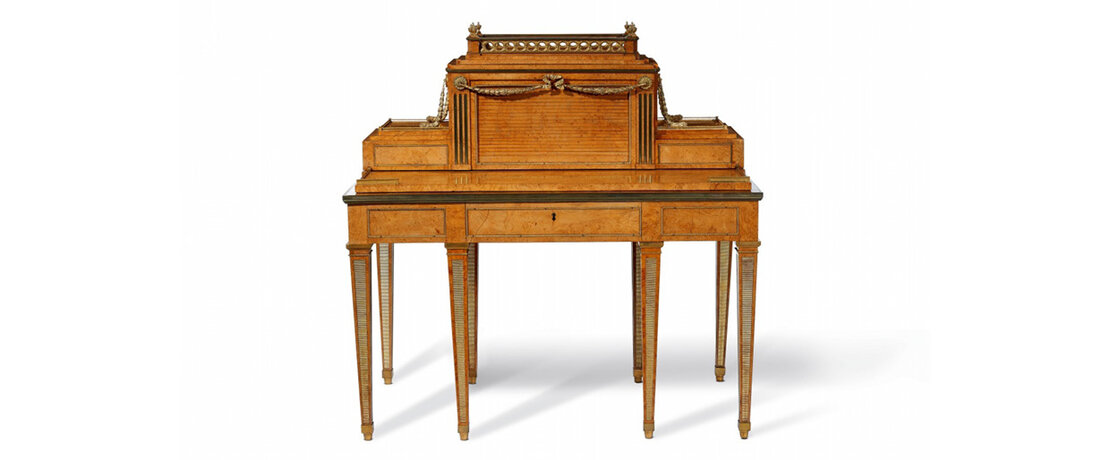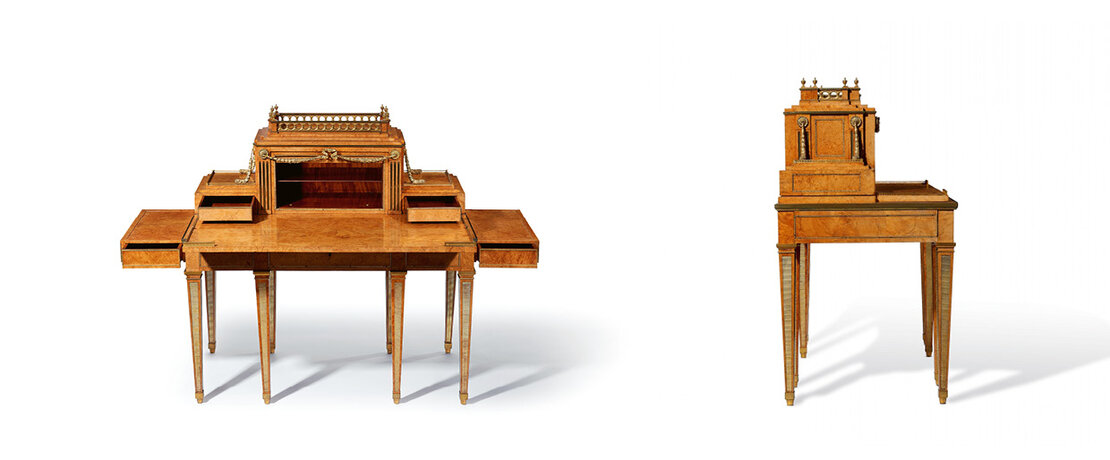An imperial writing desk by David Roentgen
This elegant desk, decorated on all sides with splendid burr veneers and fine gilt-bronze mounts, allowing the owner to place it freestanding in the centre of a room, is part of a group of bureaux with superstructure which David Roentgen only developed in the 1780s. With emphasis on its clear, architectural design, highlighted by the use of sumptuous grained veneers instead of elaborate marquetry as well as sparing use of finely chased gilt-bronze fittings to accentuate its façade, this desk is representative of the time when Roentgen not only successfully delivered to the royal court in Paris, but also caused a sensation with shipments to the imperial court in St. Petersburg, which were unsurpassed not only in quality but also in quantity.

In addition to a number of different versions of such bureaux à gradin, which were transported from Neuwied to St. Petersburg in the 1780s and of which a number are still preserved in the Imperial Hermitage as well as the Palace Museum in Pavlovsk, the famous shipment also included the most elaborate example of such desks, a magnificent example destined for Tsarina Catherine II of Russia. The virtually identical counterpart to the desk presented here, today in the Bayerisches Nationalmuseum and part of the magnificent Roentgen exhibition at the Metropolitan Museum, New York in 2012–13, was probably also originally part of Roentgen’s historic shipment of furniture to St Petersburg in 1786.
As part of the famous collection of Count Alexander Stroganov, who will have already encountered Roentgen’s furniture in Paris, when the ébéniste opened his saleroom there in the second half of the 1770s, it was sold by the Soviet Government via the Berlin auction house Lepke in 1931 and was secured for the Bayerisches Nationalmuseum in 1977. The two desks are not only of practically identical proportions, they also share the same refined mechanism. After pulling forward the desk’s writing surface and thereby also opening the connected tambour shutter of the centrally positioned Cartonnier, drawers to the left and right hand side can be released by triggering leavers concealed beneath the slide. These in turn not only open the two lateral drawers, they also release additional sprung boxes hidden within the drawers. At the push of further buttons, two additional drawers in the superstructure spring out to the left and right of the Cartonnier, the right-hand one of which is fitted to receive writing utensils. The ever-impressive presentation of such ingenious and above all hidden mechanisms was — and remains — the privilege of the proud owner, who is able to lock the desk with a single key, but who can also ‘bring it to life’.
Named ébéniste-mécanicien du Roi et de la Reine by King Louis XVI and Marie-Antoinette, and indeed ‘Privy Councillor’ by King Frederick William II of Prussia, Roentgen was a well-known brand name at the courts of Europe in the 1780s. With his severe classicist designs he had set standards, and his furniture, with its clean architectural lines, was internationally recognised as a luxury product. Working with specialists such as the clock-maker and “Mechanikus” Peter Kinzing, he was able to equip his furniture with sophisticated mechanisms, cleverly hidden secret compartments and technical wonders, which first impressed their royal and princely owners, who could in turn present these marvels to their enchanted visitors.
Johann Wolfgang von Goethe, who personally knew and respected Roentgen, wrote admiringly in “Wilhelm Meister’s Travelling Years”: “Anyone who has ever seen an artful desk by Roentgen, where many springs and compartments are set in motion by a single pull, where writing surface and utensils, compartments for letters and money unfold all at once or in quick succession, will be able to imagine how the palace unfolded into which my sweet companion now drew me”.

Exact details of the presumed ownership of this particular piece of furniture by Kaiser Wilhelm II are unfortunately not known. The Emperor will of course have been well acquainted with the large desk of similar format which Roentgen personally delivered to his great-great-grandfather, King Frederick William II of Prussia in 1789, a desk that is very similar to the above-mentioned bureau Roentgen had supplied to Catherine II a few years earlier. Given the superb collection of Roentgen furniture in the possession of the House of Hohenzollern, it will not have been difficult to arouse enthusiasm for Roentgen’s classical style and the technical refinements of his furniture from the last German Emperor and King of Prussia. Like a number of other masterpieces from Roentgen’s Neuwied-based factory, the royal Prussian desk stood in the Berlin Schloss until the 1940s, but was unfortunately lost in the turmoil of the Second World War. According to the former owners of the present desk, the Emperor sold it shortly after the First World War, i.e. when he had just moved into his Dutch exile at Huis Doorn. It is unclear, whether the desk was part of the Hohenzollern collection or whether it might have been a personal acquisition. Dealers and agents will certainly have occasionally offered valuable works of art directly to the Emperor, but with a lively art trade Berlin also offered a wide range of other opportunities. The German capital was an art trading centre of international importance at the beginning of the 20th century, Rudolph Lepke’s art and auction house, for example, was so prosperous, it invested in the construction of an impressive five-storey building in 1912. While the circumstances of the presumed imperial possession of this desk remain unknown, it is quite possible that it appeared on the art market in the early years of the last century and at the time also impressed the last German Emperor — it is certainly a piece of furniture worthy of an Imperial collection!
Author: Marcus Rädecke
Literatur
Joseph Maria Greber, Abraham und David Roentgen, 1980, Bd. 1, S. 248 und Bd. 2, Abb. Kat 704. Eremitage Museum, St Petersburg (Inv. EPR-5.090).
Wolfram Koeppe, Extravagant Inventions: The Princely Furniture of the Roentgens, 2012, Kat. 56, S. 186–187.
Dietrich Fabian, Abraham und David Roentgen, 1996, S. 86, Kat. 185. Bayerisches Nationalmuseum (Inv. L 75/222).
